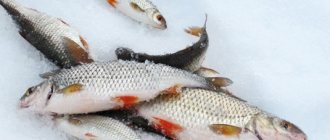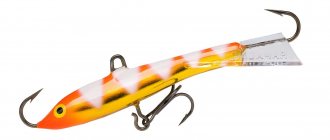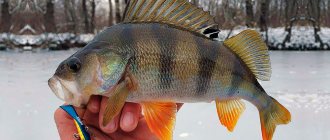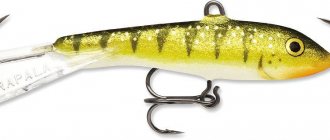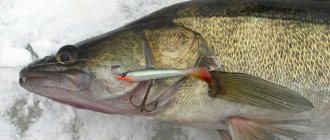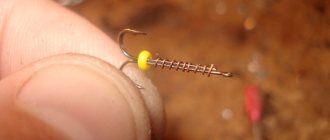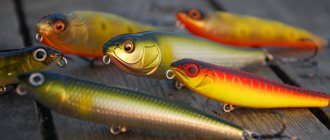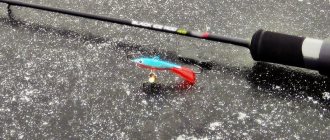Content
- Catching perch in winter on a balance beam - tactics, tackle and bait
- Catching perch in winter. Where to look for fish?
- Catching perch balancers
- Fishing technique
- Should I use a leash?
- Video: Master class on catching perch on a balance beam in winter
- How do you catch perch in winter?
In this article, we tried to collect detailed information regarding the tactics of searching for a striped predator. We recommend the best lures and talk about the technique for submitting them correctly. We share valuable advice from experts.
Balance rod
If in summer fishing we use fly rods of various lengths, then in winter, the rod should not be too long. Since catching perch in winter with a spoon and a balancer is done directly in the place where the fish accumulate.
Currently, retail chains offer ready-made fishing rods with reels or reels. If your budget allows, you can buy it. You should choose light ones with a strong but flexible whip; the total length with the handle ranges from 30 to 40 cm. A nod can be installed on a rough whip.
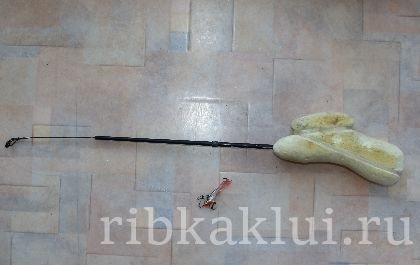
If your budget doesn’t allow it, it’s not difficult to make a fishing rod yourself. When making it yourself, you should pay attention to the material for the handle; it must be heat-insulating (wood, cork, foam, etc.).
For catching perch in winter, it is better to use fishing line rather than cord. The cord freezes and clings to the ice, which leads to the balancer’s game failure. The line catches less often, is practically invisible in the water and does not alarm the fish. The thickness of the monofilament is selected from 0.12 to 0.2, and you should focus on the weight of the bait and the intended prey. There must be at least 15 meters of fishing line on the reel spool or reel.
A leash is also not advisable; a large pike is unlikely to bite a small bait, and a small pike rarely bites through the fishing line. By using fluorocarbon instead of regular monofilament (line), the probability of cutting the bait is reduced to almost 0. It is best to tie perch balancers with a clinch knot, which minimally deforms the line, and its strength is 95%.
To quickly change baits, the fishing line can be tied not to the balancer itself, but to a special fastener to which the bait clings.
“The nod on a fishing rod with a balancer should be soft, but not springy, that is, it should stop immediately after the line is tensioned while playing with the balancer.”
Catching perch in winter on a balance beam - tactics, tackle and bait
Fishermen usually divide perch into 2 main subspecies:
- Small, “sports”, grassy. It develops very slowly and usually does not grow more than 70-100g. Forms large flocks. It feeds on small invertebrates, worms, and bloodworms.
- The deep, humpback, and okovalok are a real predator. Grows in our region for 1.5 kg. Forms not such extensive flocks. The main food is fish fry. This is what we will aim to catch on the balance beam!
Perch fishing is a very dynamic activity because... perch is a schooling and lively fish. If you manage to stumble upon a cluster of fish, then you can completely unwind! The fact is that this striped robber has a very strongly developed food competition reflex, in other words, his greed knows no bounds. He is ready to attack the bait just so that his brother from the pack does not get it. This is what experienced fishermen use.
Catching perch with balance beams is a fun and interesting way of fishing. It is believed that the best time for fishing with these baits is, first of all, the first ice, when the perch is most active. There is an opinion that during the dead winter period, when the striped fish does not have a good appetite, it is better to stir it up with smaller baits: jigs, little devils, “pussies”, etc. A separate detailed article has been written about catching perch with a jig.
According to the last ice, when the fish is preparing for spawning, full of caviar and milk, ichthyologists have the opinion that perch, during this period, has much less desire to attack large baits. But on the first ice you can get ahead of the daring, active perch 100%. But, this is just a theory!

Where to find fish
where and how to look for fish will help you have a good time and return home with your catch .
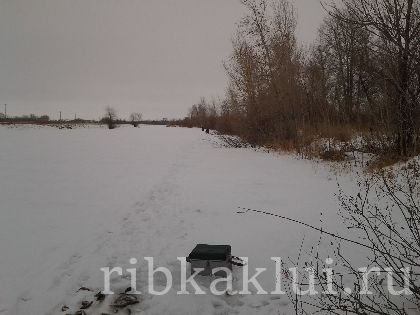
You should look for small predators up to 300 grams in the same place where small fish live, feeding on zooplankton, invertebrates and plants. Namely, at depths of up to 3-4 meters, near coastal vegetation, submerged branches of coastal bushes, not far from the bed of the stream flowing into the main body of water. The schooling predator really likes such places, since he is also not averse to snacking on all kinds of living creatures, including small fish.
In winter, large perch should be looked for in more difficult places; it prefers flooded snags, deep drops, holes on a flat plateau, or, on the contrary, a hill in a deep place, “clearings,” as experienced fishermen say.
If a small perch gathers in large schools and once caught, you can stay in one place for a long time, pulling one after another out of the hole. Large perch prefer to hunt on their own on the balance beam, and it is rare that it will be possible to lift a decent number of humpback whales over 800 grams from one hole.
You can also determine where the fish were biting by other signs. A large number of holes in one place, the remains of bait around the holes (the best bait for perch, and even for peaceful fish, the amphipod crustacean “mormysh”), a mark rising above the ice and snow (a bunch of straw, a tree branch, etc.).
Anecdote A fisherman was traveling from fishing on a shuttle bus and forgot a bag of fish under the seat. Three days later he reads an advertisement in the newspaper. “A fisherman who left a bag of fish on bus No. 38 can come to the garage and pick up the Bus.”
Catching perch in winter. Where to look for fish?
At the beginning of winter, it is better to look for fish in relatively shallow water, in snags, near the remains of last year’s vegetation. You need to drill holes over a large area, in a checkerboard pattern every 5-7 meters. There is no point in staying on one hole for more than 10 minutes. The main thing is to find the fish and get the first bite! They start the search with small baits, and after the flock has revealed its location, they increase the size in order to catch the real trophy - the largest humpback whale from the flock.
Despite the apparent simplicity of fishing with a balance beam, there are quite a lot of nuances and small secrets. Sometimes the perch has to be “winded up” and rocked. The method is aimed at creating competition in a school of fish. Even a not-hungry perch begins to attack the bait if it sees that its comrades are trying to snatch something from under their noses.
To do this, they select the balancer by size, color and, most importantly, change the game. From sharp tossing in different water levels, pauses of different durations, to short shaking and hovering - “mormyshing”. If the plan works out, then the running “conveyor” will bring a large number of perches.
During the deep winter period, the predator moderates its ardor and becomes more passive. It is becoming increasingly difficult to provoke him to bite. Only on the most favorable days can you count on a good bite. At this time, it moves to deeper sections of the river: river bends, holes with a snagged bottom, boulders, etc. Places where it is comfortable to be protected from the current, in well-oxygenated water. In reservoirs you need to look for perch at large differences in depth, near navels, dumps near islands.
Closer to spring, schools of perch move to the shallows, where the water is more quickly saturated with oxygen from melt water. At this time of year it can be caught in 30 cm depth. Watching how the striped ones try to get ahead and steal your balancer from under each other’s noses!
There is no secret that the basic principles in any winter fishing are to move around a lot, drill, search, experiment more often with baits and methods of placing them.
How to catch pike with a balance beam
You can catch the toothy beast on the ice at the beginning of winter, in the middle, and at the end. Prey hunting can happen on almost any body of water, the main thing is to know where to look and how to catch.
Catching pike on a balancer on the first ice
Catching pike on the first ice on a balance beam is always promising and exciting. The fish are quite active and respond well to artificial baits. Models with a length of 50–70 mm have increased catchability. The best results are observed with vertical lures; the balancer is used when there is a high probability of losing an expensive lure.
In the wilderness
In the middle of the cold season, the toothy robber shows mostly passive behavior, she is practically not interested in the offered bait. She can see the fish playing, but not take any decisive action.

To catch a sedentary pike under the ice, you will need to examine more than a dozen holes. The optimal distance between working points is 5–7 m. They can be drilled according to any pattern. You can simplify the task of searching for promising areas on a specific body of water with the help of such a modern gadget as an echo sounder. It will determine the depth in a matter of seconds and study the bottom surface. Since it is unlikely that it will be possible to stir up a sluggish fish with sudden movements, more delicate tactics should be used.
On the last ice
At the end of winter, when the ice becomes quite loose, the fish go to spawn. This happens at the end of February - at the beginning of March. The increased activity of pike only benefits the angler. She throws herself at everything that is offered to her. The size of the artificial fish should be from 70 mm. Additional equipment includes feathers and planes that help change the direction of the balancer when moving under water. You need to play confidently, actively, with sharp twitches in a vertical position.
On the river
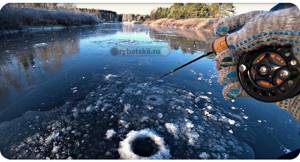
The river balancer is mainly used in hard-to-reach places. It is not subject to snags, which is its advantage. If you use large versions weighing from 32 g, then during the current they will be able to fully demonstrate all their abilities.
Among the favorite places for spawning, pike chooses small rivers and the upper reaches of large ones. There are steep banks and a large amount of bottom vegetation. Consequently, there are many places where you can set up an ambush.
On the lake
To attract the attention of a predator, you need to play the tackle correctly. Pike are caught on the first ice here at a shallow depth, 2–3 m. Areas bordering reed thickets should be fished. During the deep winter period, the fish are in wintering pits, falling into suspended animation. As warm weather approaches, she goes out into shallow water to breed. Here it makes sense to take several different baits with you.
In the snag
Considering the high probability of a snag, you should choose areas of the reservoir that are freer from snags for pike hunting. The working depth should be 2–3 m. Wiring is done in the horizontal direction.
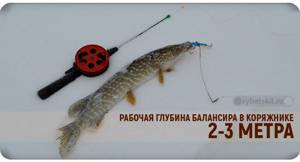
It is quite possible to catch pike in winter if the fishing rod rig for the balancer is prepared correctly. Only durable and effective gear can cope with the predator under the ice. The technique of catching pike on a balance beam is not complicated, the main thing is to drill at least 10 holes and not wait more than 5 minutes at one point. If there are no bites, then immediately move on to the next one.
Catching perch balancers
For catching perch, balancers with a length of 3 to 7 cm are often used. For rivers and currents, choose heavier models; for lakes and the sea, you can get by with more elegant and lighter options. The most common colors are acidic and natural. Both of them should be in every angler’s arsenal. If you have teased the fish and it is active, then by and large, it makes no difference what color your bait is. Perhaps this plays a role when you need to seduce capricious fish. Then the angler changes the size, color and game of the balancer, selecting the key.
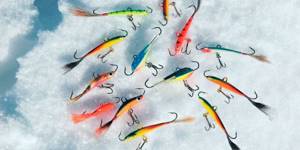
If the tee from the factory is not equipped with a bright droplet or red insulation, then it is recommended to do it yourself. It is believed that this provokes the fish and creates an attack point, focusing the fish's attention on the treble.
When biting is active, many fishermen bite off the front or rear hook of the bait, thereby, when fishing, the balancer less often clings to the edge of the ice, preventing annoying slips.
Top 5 manufacturers that have proven themselves in our water area:
- Rapala
- Lucky John
- Strike Pro
- Nils Master
- Merkuri
In this forum thread, experienced fishermen compare different brands of balancers. Before you run to the store to buy, read the opinion of the masters.
Balancers rating
Over the years, fishing has selected the best balancers for perch. These include:
- Jigging Rap from Rapala, designed for hunting at a depth of up to 2 meters. The size range goes from 2 to 7 centimeters. Playing with bait depends on the activity of the fish; active bait responds better to sharp swings and short pauses, passive bait responds better to smooth, wide pauses that last up to 10 seconds.
- Pliant from “Lucky John” is designed for depths up to 1 meter and is excellent for searching for active perch. Ugra: short, sharp jerks.
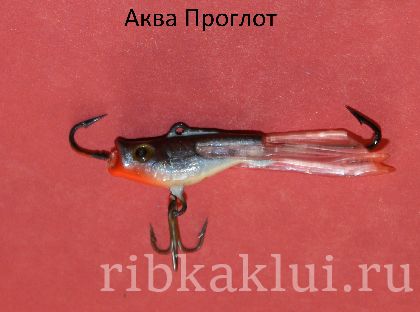
Proglot manufacturer “Aqua”. The working depth of the bait is from 40 centimeters. Great for beginner spinners.- Baby Shad from “Nils Master”. Application: from 1.5 meters and deeper. A catchable bait that does not require special animation.
- Hopper product “Aqua”. Seduces passive fish at depths from 40 centimeters to 4 meters.
- Jigger manufacturer “Nils master”. The search fish on the first ice works from 0.4 to 4 meters. Size: 3 centimeters in length, 4 grams in weight.
The listed models cannot always be found on sale, for this reason you will have to use other brands, and it is best to have in stock several perch balancers of different colors and shapes.
Catching balancers for perch in winter have a thin body, an optimal size of 7.5 cm in length, are heavy, and large ones are more likely to scare away the fish than to force them to be tempted by the bait.
Fishing technique
2 years ago we wrote an excellent article in which we not only talked about choosing a balancer, but also described in detail the fishing technique. Therefore, we will not dwell on this point in detail. This article also provides practical advice from experienced professionals from our city. Be sure to check it out before you hit the ice!
To clearly master the basic techniques of working with bait, we recommend paying attention to the video from the famous Shcherbakov brothers.
The most important thing is to remember that it is not the magic balancer that catches, but the fisherman’s arms, legs and head!
But what specific balancers should still be in the arsenal of every striped trophy hunter is discussed here.
Should I use a leash?
There is a lot of debate on the topic - should you use a leash when you hunt for perch? In our opinion, if you are catching perch in a river snag, you should use a small thin leash, because In these characteristic places, in addition to perch, pike are often bitten. It seems to us inappropriate to leave the working balancer in her mouth. The presence of a leash does not have a significant effect on the bite of an active perch. As a last resort, to “sway” a finicky predator, you can remove the leash, and after the flock has become interested in the bait, put it back and continue fishing.
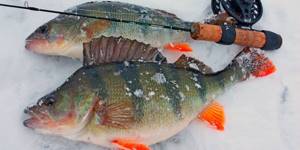
It doesn’t make much sense to put a leash on the OVH. Since we have little pike in the sea, its bites are rare. The main predator is pike perch and perch!
But here everyone chooses for themselves - both with their wallet and their own experience.
